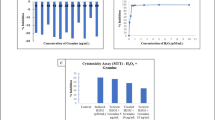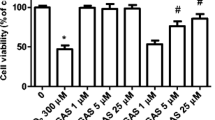Abstract
Oxidative damage leads to many diseases. In this study, we evaluated the antioxidant effects of 70% ethanol extract of Geranium nepalense (GNE) on hydrogen peroxide-induced cytotoxicity in cell lines: H9c2, SH-SY5Y, HEK293, and BEAS-2B. We determined the free radical scavenging activity of GNE using 2,2-diphenyl-1-picrylhydrazyl (DPPH), 2,2′-azino-bis(3-ethylbenzothiazoline-6-sulphonic acid) (ABTS), and superoxide dismutase-like activities, as well as the polyphenol and flavonoid contents of GNE. The results showed that GNE scavenged DPPH and ABTS radicals in a dose-dependent manner. In addition, it contained abundant contents of total polyphenol and flavonoid contents and strongly suppressed cellular reactive oxygen species, thereby protecting H2O2-induced cytotoxicity in H9c2, SH-SY5Y, HEK293, and BEAS-2B cell lines. The powerful antioxidant activity exhibited by GNE, both in vitro and in cell systems, was attributed to its free radical scavenging activity. Therefore, GNE may be useful in preventing oxidative stress-induced diseases including Alzheimer’s disease, respiratory inflammatory disease, and chronic kidney diseases.





Similar content being viewed by others
References
Aiyegoro OA, Okoh AI. Preliminary phytochemical screening and in vitro antioxidant activities of the aqueous extract of Helichrysum longifolium DC. BMC Complement. Altern. Med. 10: 21-6882-10-21 (2010)
Valko M, Rhodes CJ, Moncol J, Izakovic M, Mazur M. Free radicals, metals and antioxidants in oxidative stress-induced cancer. Chem. Biol. Interact. 160: 1–40 (2006)
Stadtman ER. Role of oxidant species in aging. Curr. Med. Chem. 11: 1105–1112 (2004)
Jenner P. Oxidative stress and Parkinson’s disease. Handb. Clin. Neurol. 83: 507–520 (2007)
Birben E, Sahiner UM, Sackesen C, Erzurum S, Kalayci O. Oxidative stress and antioxidant defense. World Allergy Organ. J. 5: 9–19 (2012)
Valko M, Leibfritz D, Moncol J, Cronin MT, Mazur M, Telser J. Free radicals and antioxidants in normal physiological functions and human disease. Int. J. Biochem. Cell Biol. 39: 44–84 (2007)
Ferreira IC, Barros L, Abreu RM. Antioxidants in wild mushrooms. Curr. Med. Chem. 16: 1543–1560 (2009)
Carocho M, Ferreira IC. A review on antioxidants, prooxidants and related controversy: natural and synthetic compounds, screening and analysis methodologies and future perspectives. Food Chem. Toxicol. 51: 15–25 (2013)
Kanter M. Free radicals, exercise and antioxidant supplementation. Proc. Nutr. Soc. 57: 9–13 (1998)
Saeed N, Khan MR, Shabbir M. Antioxidant activity, total phenolic and total flavonoid contents of whole plant extracts Torilis leptophylla L. BMC Complement. Altern. Med. 12: 221–228 (2012)
Lai LS, Chou ST, Chao WW. Studies on the antioxidative activities of Hsian-tsao (Mesona procumbens Hemsl) leaf gum. J. Agr. Food Chem. 49: 963–968 (2001)
Gulcin I. Antioxidant activity of food constituents: an overview. Arch. Toxicol. 86: 345–391 (2012)
Lu CH, Li YY, Li LJ, Liang LY, Shen YM. Anti-inflammatory activities of fractions from Geranium nepalense and related polyphenols. Drug Discov. Ther. 6: 194–197 (2012)
Okuda T, Mori K, Hatano T. The distribution of geraniin and mallotusinic acid in the order geraniales. Phytochem. 19: 547–551 (1980)
Ling LT, Saito Y, Palanisamy UD, Cheng HM, Noguchi N. Cytoprotective effects of geraniin against peroxynitrite- and peroxyl radical-induced cell death via free radical scavenging activity. Food Chem. 132: 1899–1907 (2012)
Wang P, Peng X, Wei FY, Wang W, Ma WD, Yao LP, Fu YJ, Zu YG. Geraniin exerts protective effect against cellular oxidative stress by upregulation of Nrf2-mediated antioxidant enzyme expression via PI3 K/AKT and ERK1/2 pathway. BBA Gen. Subjects 1850: 1751–1761 (2015)
Folin O, Denis W. On phosphotungstic-phosphomolybdic compounds as color reagents. J. Biol. Chem. 12: 239–243 (1912)
Moreno MI, Isla MI, Sampietro AR, Vattuone MA. Comparison of the free radical-scavenging activity of propolis from several regions of Argentina. J. Ethnopharmacol. 71: 109–114 (2000)
Blois MS. Antioxidant determinations by the use of a stable free radical. Nature 71: 109–114 (1958)
Pellegrini N, Re R, Yang M, Rice-Evans C. Screening of dietary carotenoids and carotenoid-rich fruit extracts for antioxidant activities applying 2, 2′-azinobis (3-ethylenebenzothiazoline-6-sulf onic acid) radical cation decolorization assay. Meth. Enzymol. 299: 379–389 (1999)
Dudonné S, Vitrac X, Coutiere P, Woillez M, Mérillon J. Comparative study of antioxidant properties and total phenolic content of 30 plant extracts of industrial interest using DPPH, ABTS, FRAP, SOD, and ORAC assays. J. Agr. Food Chem. 57: 1768–1774 (2009)
Pandey KB, Rizvi SI. Plant polyphenols as dietary antioxidants in human health and disease. Oxid Med. Cell. Longev. 2: 270–278 (2009)
Beckman CH. Phenolic-storing cells: keys to programmed cell death and periderm formation in wilt disease resistance and in general defense responses in plants? Physiol. Mol. Plant Pathol. 57: 101–110 (2000)
Procházková D, Boušová I, Wilhelmová N. Antioxidant and prooxidant properties of flavonoids. Fitoterapia 82: 513–523 (2011)
Lee SY, Kim HJ, Choi SW. Study on the antioxidant activity of Geranium nepalense subsp. thunbergii extract. J. Soc. Cosmet. Scientists Korea. 37: 61–66 (2011)
Park C, So HS, Baek SH, Moon BS, Shin SH, Lee HS, Lee DW, Park R. Quercetin protects the hydrogen peroxide-induced apoptosis via inhibition of mitochondrial dysfuction in H9c2 cardiomyoblast cells. Biochem. Pharmacol. 66: 1287–1295 (2003)
Park HR, Lee H, Park H, Jeon JW, Cho W, Ma JY. Neuroprotective effects of Liriope platyphylla extract against hydrogen peroxide-induced cytotoxicity in human neuroblastoma SH-SY5Y cells. BMC Complement. Altern. Med. 15: 171 (2015)
Cho I, Choi Y, Gong J, Shin D, Kang M, Kang Y. Astragalin inhibits autophagy-associated airway epithelial fibrosis. Respir. Res. 16: 51 (2015)
Liu C, Ma J, Sun Y. Quercetin protects the rat kidney against oxidative stress-mediated DNA damage and apoptosis induced by lead. Environ. Toxicol. Pharmacol. 30: 264–271 (2010)
Jiang L, Diaz PT, Best TM, Stimpfl JN, He F, Zuo L. Molecular characterization of redox mechanisms in allergic asthma. Ann. Allergy Asthma Immunol. 113: 137–142 (2014)
Söhretoğlu D, Sabuncuoğlu SA, Sakar MK, Ozgüneş H, Sterner O. Antioxidant effects of secondary metabolites from Geranium psilostemon. Nat. Prod. Commun. 5: 889–902 (2010)
Sabuncuoğlu S, Şöhretoğlu D. Evaluation of antihemolytic and antioxidant activities of Geranium tuberosum subsp. tuberosum with in vitro models. Pharm. Biol. 50: 1374–1379 (2012)
Acknowledgements
This study was supported by the Ministry of Health & Welfare [The Traditional Korean Medicine Industry Development Product R&D Program].
Author information
Authors and Affiliations
Corresponding author
Ethics declarations
Conflict of interest
The authors declare no conflict of interest.
Rights and permissions
About this article
Cite this article
Sim, MO., Jang, JH., Lee, HE. et al. Antioxidant effects of Geranium nepalense ethanol extract on H2O2-induced cytotoxicity in H9c2, SH-SY5Y, BEAS-2B, and HEK293. Food Sci Biotechnol 26, 1045–1053 (2017). https://doi.org/10.1007/s10068-017-0130-2
Received:
Revised:
Accepted:
Published:
Issue Date:
DOI: https://doi.org/10.1007/s10068-017-0130-2




